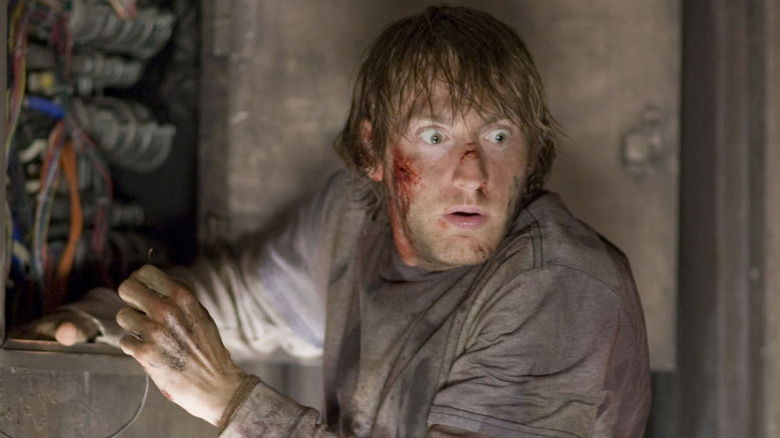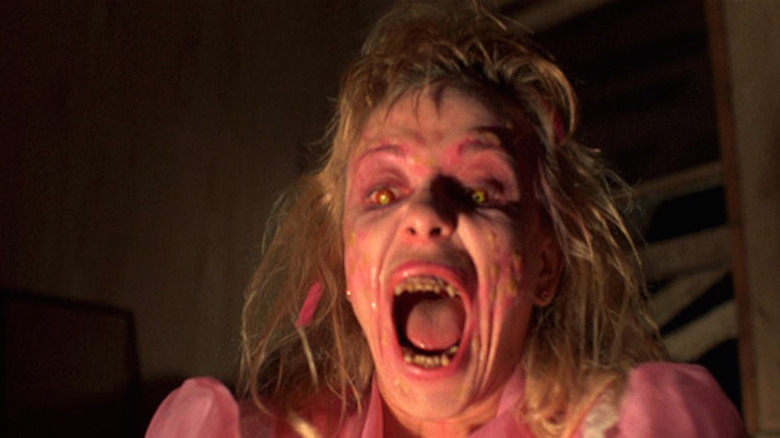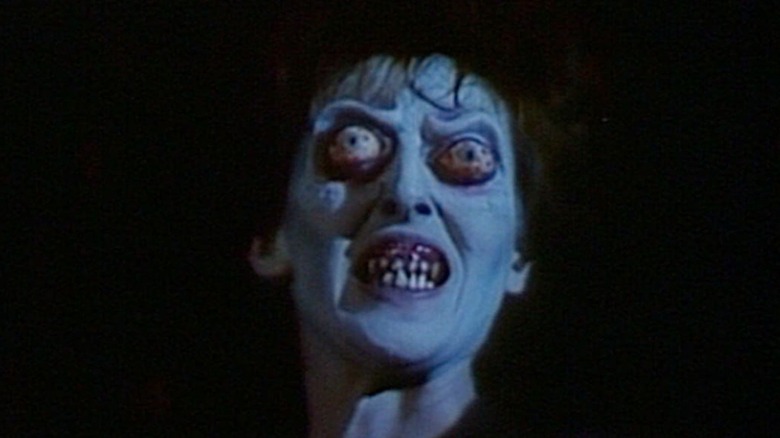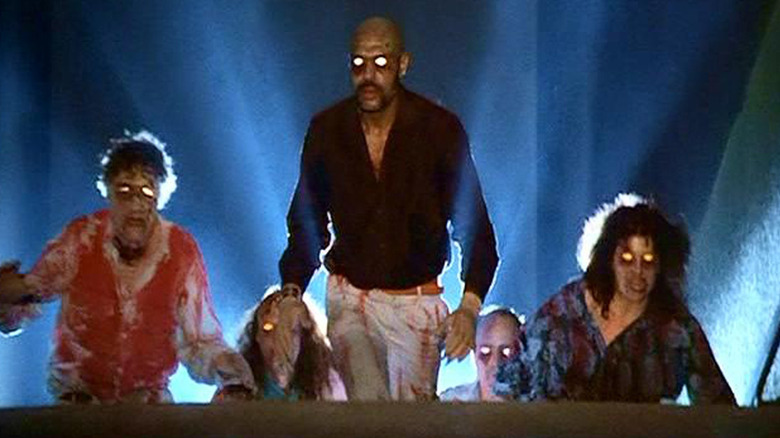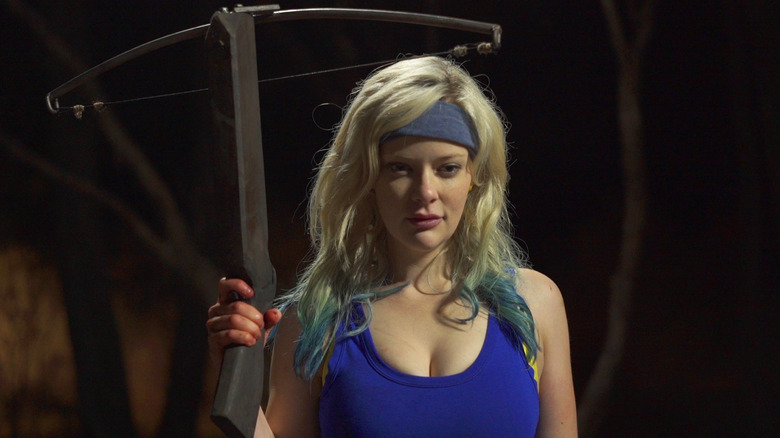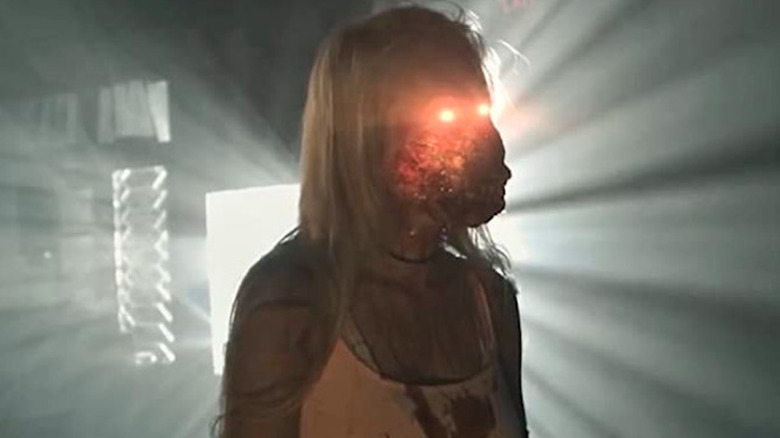Horror Movies That Copied The Evil Dead Franchise
When director Sam Raimi, executive producer Rob Tapert, and associate producer/star Bruce Campbell set out into the Tennessee woods in 1980 to work on a long-gestating low-budget horror movie called "The Evil Dead," they had no idea they'd produce not only what Stephen King called the "most ferociously original film of the year" (via ETOnline) but also a terrifying horror franchise that would generate three movies, a 2013 reboot, a short-lived but well-loved TV series, and countless related media offshoots.
With "Evil Dead" and its follow-up features — "Evil Dead 2" in 1987 and "Army of Darkness" in 1992 — they brought together extreme horror, absurd humor, and inventive filmmaking in a groundbreaking manner that propelled them to varying degrees of stardom, yielding such projects as "Spider-Man" in 2002 and "Doctor Strange in the Multiverse of Madness" in 2022, as well as the popular "Xena: Warrior Princess" series and Campbell's enduring status as a cult hero and author.
As with many popular horror films, "Evil Dead" also influenced other genre filmmakers (and a few outside the horror field, like their friends Joel and Ethan Coen). Some films, like Edgar Wright's '"Shaun of the Dead" or Drew Goddard's "The Cabin in the Woods," paid tribute to the film while also forging its own path. Others simply aped its best moments, hoping that these scenes would trigger some goodwill from horror fans.
As moviegoers prepare to return to the "Evil Dead" universe with the 2023 release of "Evil Dead Rise," here's a (spoiler-heavy) list of horror films that — depending on how you look at it — were either influenced by the "Evil Dead" franchise or outright copied it.
The Cabin in the Woods (2011)
To say that Drew Goddard's "Cabin in the Woods" copies "Evil Dead" is more of a judgment call than an indisputable fact: Goddard and Joss Whedon frontload their 2011 meta-horror film with references to numerous horror films, from the "Ringu" cycle to "The Shining," "Hellraiser," and George Romero's zombie films. Calling these references "copies" really depends more on how much you like "Cabin in the Woods" — it's an homage if you're a fan, and a copy if you're a detractor.
Having said that, it's worth noting that there seems to be more references in "Cabin" to "Evil Dead" than any other film. The titular setting has a very similar layout to the ramshackle cabin visited by Ash and friends in the first two "Evil Dead" films, with a stone fireplace, a creepy cellar with a trapdoor entrance, and a smattering of taxidermied animal heads. That cellar also houses another "Evil Dead" reference in Patience Buckner's diary, which contains the incantation to bring the family back to life, much in the same way as the Necronomicon Ex-Mortis/Naturom Demonto does in the "Evil Dead" films.
The other major "Evil Dead" references in "Cabin" are glimpsed briefly on the infamous betting whiteboard, which lists the Facility's menagerie of monsters. Included on the list are Deadites — the humans possessed by evil spirits in "Evil Dead." Also on the board: the infamous tree, dubbed the Angry Molesting Tree, from the 1981 "Evil Dead."
Dead Alive (1992)
Peter Jackson's 1992 horror comedy "Dead Alive" is also more of a loving homage to the gonzo spirit of "Evil Dead" and especially "Evil Dead 2" than a rip-off. Jackson's film, a gleefully crass exercise about a zombie plague (caused by an absurd rat-monkey creature) in a sedate suburb of his native New Zealand, comes closest to evoking both the outrageous blend of gory special effects and broad humor, as well as the bravura camerawork of Raimi's films.
There are certain similarities between the two films: The romance between nervous hero Lionel (Timothy Balme) and Diana Penalver's innocent Paquita echoes Ash's relationship with Linda in the first two films (though their boyfriend-girlfriend status is doomed from the start), and the unorthodox use of power tools in Ash's chainsaw and Lionel's lawn mower, both of which result in overwhelming showers of gore. But beyond that, the links are purely of tone, energy and humor.
A Chinese Ghost Story (1987)
A delirious mix of genres and influences, the Hong Kong fantasy "A Chinese Ghost Story" fuses together elements of classic wuxia (swordplay films) and martial arts action, comedy, spicy romance, Chinese folklore and a dash of Western horror into its story of a debt collector (Hong Kong leading man Leslie Chung) who catches the eye of a devious ghost (Joey Wang). For the horror component, director Ching Siu-Tung and producer Tsui Hark channeled Sam Raimi's "Evil Dead" to lend a touch of anarchy to its army of malevolent spirits.
Both films feature monstrous trees; to bring its terrible Tree Demon to life, the "Ghost Story" filmmakers use a first-person perspective to add tension to its pursuit of Chung. "Evil Dead" is also quoted in scenes where the Tree Demon grabs its prey with talon-like branches. There are also dead bodies brought back to life by dark magic, though its hordes of hopping jiangshi in "Chinese Ghost Story" hew closer to vampires or zombies than Deadites.
Bio Zombie (1998)
The brash, goofy Hong Kong horror comedy "Bio Zombie" might be considered a copy of "Evil Dead" once removed.
The film — an early credit for "Ip Man" director Wilson Yip — features a frequently frantic pace and gore-splashed humor that suggest the influence of Peter Jackson's "Dead Alive" (and as noted, that film has "Evil Dead" in its DNA). But "Zombie" is a looser, sloppier film than both "Evil Dead" and "Dead Alive" — the story, about various slackers avoiding a zombie outbreak in a Hong Kong shopping mall, feels overlong and stale before the end credits — in its best moments, however, it seems to tap into the same creative energy.
The most memorable of these are nods to first-person shooter games like "Resident Evil" and "House of the Dead," which manifest themselves as on-camera data about the surviving characters. Stars are given — weapon readiness and power levels — as well as the characters' signs and idols (for "Bio Zombie" goofball gangster hero, Woody, it's "Japanese underwear models"), and in an inspired moment, a character about to face death displays a "low battery" icon. Raimi and Jackson would undoubtedly approve of such deliberately cartoonish sight gags.
Night of the Demons (1998)
Kevin S. Tenney's "Night of the Demons" is a silly, raunchy splatterfest about teenage knuckleheads who unwittingly release a demon during a Halloween party at a crematorium. It has a smattering of inventive special effects and camerawork, a lot of rude humor, and Linnea Quigley in '80s scream queen mode, all of which somehow added up not only to cult status but also two sequels and a 2009 remake. However, any of its creative successes are due largely to elements cribbed from "Evil Dead."
"Night" lifts its basic premise from the Raimi film — here, it's teens who inadvertently release evil spirits in an abandoned mortuary instead of a cabin in the woods — and also borrows both the look and the vicious behavior of his monsters for its possessed partygoers. Tenney also apes Raimi's gliding camerawork to suggest the point of view of his demons as they pursue the survivors through the mortuary. None of these work as well as they did in "Evil Dead," but they undoubtedly helped endear "Demons" to '80s horror fans.
Bloody Muscle Body Builder in Hell (1995)
The most obvious choices for a Japanese "Evil Dead" carbon would seem to be the "Evil Dead Trap" films, a trio of extremely gruesome but unconnected J-horror films released between 1988 and 1993. However, the features have nothing to do with Sam Raimi's films beyond their English-language titles. The "real" Japanese "Evil Dead" carbon is the wonderfully titled, completely berserk "Bloody Muscle Body Builder in Hell." Shot entirely in grainy Super 8mm, "Body Builder" is an ardent love letter to the first two "Evil Dead" films from writer/director Shinichi Fukazawa, who began production in 1995 but took nearly 20 years to complete it.
Fukazawa also stars as the titular strongman, who joins his reporter ex-girlfriend and a psychic on an investigation into a haunted house — which just happens to be the same place where, years ago, his father murdered his mother. This fact doesn't seem to bother Fukazawa, but when his mother's enraged spirit appears and the blood starts flowing, he kicks into Ash Williams gear and doles out a beatdown with his dumbbells.
"Body Builder" appears to lack even the microscopic budget of the first "Evil Dead" film, which is evident by the limited sets (one house) and very crude make-up effects (goopy blood, rubbery limbs). What it does have is energy to spare: Fukazawa doesn't have the money to pull off a screaming head moving around on a severed hand, but that's doesn't stop him from trying, and his camera and actors appear to be in a state of perpetual frenetic motion. At just over an hour in length, "Body Builder" is too brief to run out of steam, and barrels towards its final showdown with a relentless, Raimi-like kinetic energy.
Bach ke Zara (2008)
Like their counterparts in the United States and Europe, Indian filmmakers working on low-budget fare often turn to established hits to fuel their own projects, resulting in a bizarre masala of Hollywood and indie filmmaking tropes with the distinctly overripe style of Bollywood moviemaking.
"The Evil Dead" has served as inspiration (or more) for several direct-to-video Indian horror movies; the book How the World Remade Hollywood cites 1984's "Pyasa Shaitan," 1987's "Veedum Lisa" and "Aadamkhor Hasina" (2004), all of which feature variations on the notorious tree attack scene from "Evil Dead." The 2007 Telugu-language movie "Bhayam" takes the adulation several steps further by not only presenting a shot-by-shot microbudget version of "Evil Dead" but also even slipping in footage from "Evil Dead II," which plays on a TV screen in the film.
"Bach ke Zara" ("Tread Carefully") — also known as "Bollywood Evil Dead" — is nearly a shot-by-shot remake of "Evil Dead," reproducing lines of dialogue from the script, the innovative makeup effects, and even props from the film. Director Salim Raza — who made his feature directorial debut with "Bach ke Zara" — clearly knows and loves "Evil Dead," though he's hampered at every turn by a budget that's clearly even lower than the source material. Nevertheless, he clearly saw room for improvement in Raimi's film, which explains the lengthy sex scene between his version of archaeologist Raymond Knowby and wife. Not content with melting minds with that sequence, Raza also added two non-sequitur musical numbers — one performed by a demon (!) and the other a music video-style sequence featuring starlet Rahki Sawant — that also has nothing to do with "Evil Dead."
Evil Clutch (1988)
The Italian "Evil Dead" knockoff "Evil Clutch" ("Il Bosco 1") opens with a prologue in which a woman extrudes a taloned hand from a very private place on her person and grabs an unlucky man in an equally personal spot. That moment not only explains the curious title of this 1988 production, but also sets the tone for the crude splatter to follow.
The plot, which pits the woman (Elena Cantarone), who's a demon disguised as a hitchhiker, against a couple vacationing in the Italian Alps is from writer/director Andreas Marfoni, who liberally samples from the "Evil Dead" playbook to detail the demon hitcher's attack. Included are an evil tree, a reanimated zombie with a chainsaw, and even approximations of Raimi's "shaky cam," though these tend to induce more nausea than excitement.
"Evil Clutch" does offer one novel moment: It's the faux Ash that ends up dead in the film's conclusion, leaving girlfriend Cindy (Coralina Cataldi-Tassoni, also in "Demons 2") to pick up a chainsaw and fight it out with Cantarone. However, Cantarone is revived before the end titles, so it all amounts to naught — which is also a good way to summarize "Evil Clutch."
Demons (1985)
As Italian-made "Evil Dead" carbons from the 1980s go, "Demons" is a vast improvement over "Evil Clutch," though in all honesty, just about anything is better than "Evil Clutch." Noting that "Demons" is a better movie than "Evil Clutch" doesn't also mean that it's a particularly good picture. Directed by Lamberto Bava — son of the pioneering Italian genre filmmaker Mario Bava — and produced by Dario Argento in 1985, "Demons," which concerns a group of moviegoers trapped in a theater with the title monsters, is saddled with a nonsensical plot and characters that hover somewhere between cardboard and offensive (looking at you, Tony the pimp).
But "Demons" has first-rate monsters — snarling, scaly fiends that painfully force their way out of their victims (courtesy of uncredited special effects creator Sergio Stivaletti) — that are clearly inspired by the shrieking Deadites, especially in the finale of the first "Evil Dead" feature, when huge hands erupt from the bodies of Scott and Cheryl. Once they make the scene, the film shifts into high gear and becomes a terrific comic book-style game of survival. A sizable hit in Europe and a favorite on home video in the States, "Demons" was followed by an even wilder and weirder sequel in 1986, which shifted the action to a high-rise apartment.
The Evil Dead Inbred Rednecks (2010)
At 45 minutes in length, "The Evil Dead Inbred Rednecks" is more of an extended sketch than a film — and too brief to offend anyone — but it certainly tries to accomplish that in every frame.
This 2010 "comedy," shot on video in the Finger Lakes region of New York, opens with a male actor in women's clothes ranting at length about the many ways in which the movie itself is a disaster; the plot then kicks in with the rednecks of the title, a gaggle of foul-mouthed buffoons obsessed with bodily functions. A Book of the Dead is discovered and summons the ghost of a serial killer who proceeds to turn each of them into... more of a redneck? A redder sort of redneck? No matter, a Michael Jackson impersonator is on hand to face off against this very stoppable evil.
Suffice it to say that if you love the "Evil Dead" movies but wish they made room for fart jokes, King of Pop jokes and euphemisms for body parts, "Evil Dead Inbred Rednecks" is the answer to your prayers. The bottom line: It's a deliberately "bad" movie that lacks the unique surprises or humor that come from films that are made inept by accident or misfortune, or present an offbeat vision. Watch at your peril.
Cabin Fever (2002)
Eli Roth is not shy about paying tribute to his favorite horror films in his own work: his "Hostel" movies acknowledge the influence of harrowing Japanese films like "Audition" and "Ichi the Killer," while "Green Inferno" was inspired by Italian cannibal movies from the 1970s. Roth's debut feature, 2002's "Cabin Fever," also cites a handful of classic genre titles, including "Last House on the Left," "The Shining," "Night of the Living Dead," and "Deliverance." However, it's "Evil Dead" that receives the most explicit referencing by Roth's film, from its setting and premise to the nature of its core horror.
The most obvious reference to "Evil Dead" is its cabin-in-the-woods setting, where a quartet of college students enjoys spring break before they contract a highly contagious, destructive blood infection. The first of the group to show signs of the disease is Jordan Ladd's Karen, whom they send to a shed to rein in the rate of infection (just as Ash and friends locked Cheryl in the cabin's cellar to prevent them from also becoming possessed). But infection in "Cabin Fever" and possession in "Evil Dead" operate under similar circumstances: individuals are fine one moment and monsters the next, and the connection between demonic takeover and disease is implicitly referenced.
Wither (2012)
Though the idea of a "Swedish 'Evil Dead'" conjures up some unusual mental images — tall, impossibly blond and exceedingly friendly Deadites, for one — that label is 100% accurate as a description for 2012's "Vittra" ("Wither"). Co-writers/producers/directors Sonny Laguna and Tommy Wiklund offer homage to the Sam Raimi classic with their gore-soaked story of couples combating evil spirits in a remote cabin.
Here, the demonic entity is a vittra, a figure from Scandinavian mythology traditionally depicted as a little person (as seen in the animated series "Hilda"). However, the Vittra in "Wither" is a human-sized monster covered in mud and other forest debris that turns others into more vittras, or vittor, through infection.
Such an arrangement means that "Wither" is absolutely soaked in blood, either spat by the vittra at its human victims — here, a young Ash-and-Linda carbon and friends and siblings — or gushing from wounds caused by its attacks. To kill one of the creatures also requires a great deal of blood to be spilled (from chopped-off and crushed heads, gunshot wounds, and a well-placed refrigerator), so it's safe to say that "Wither" is not for the squeamish. It is, however, an excellent introduction to Laguna and Wiklund, who went on to direct the horror comedy "Puppet Master: The Littlest Reich."
Damned by Dawn (2009)
Image Entertainment, which distributed the Australian horror film "Damned by Dawn" on Stateside home video, clearly support comparisons between their title and "Evil Dead": The DVD packaging quotes a review encouraging those "sick of waiting for 'Evil Dead 4'" to check out this film. The comparisons aren't entirely inaccurate: there's the title, of course, which resembles the "Evil Dead 2" subtitle ("Dead by Dawn") and its location (a rundown farmhouse) and its occupants undergoing a siege by blood-soaked phantoms led by a screeching female spirit — a Banshee, we're told, though there's more than a bit of Henrietta from "Evil Dead 2" in her (albeit in death metal corpse paint). Those killed by the ghosts return as Deadite-like ghouls, spewing fluids and issuing threats.
The comparisons to "Evil Dead" probably helped earn "Damned By Dawn" an audience among Stateside horror fans, though it might have fared well enough without the connection. Writer/director Brett Antsey shows a grasp of both grisly setpieces and slow-building tension, though his work is occasionally undone by less-than-convincing CGI and makeup. It's unfortunate that "Damned by Dawn" appears to be his only feature-length directorial effort to date, since it's clear that he can produce work that rises above the label of "Evil Dead" copy.
Creature Cabin (2017)
"Damned by Dawn" wasn't the only "Evil Dead"-inspired Aussie horror film. Nearly a decade after its release, 2017's "Creature Cabin" took another set of Antipodean twenty-somethings to a cabin in the woods, where they faced off against a horde of demons. And that is where the similarities between the two films end. If "Damned By Dawn" is a straight-faced attempt to fold Raimi's gory, jittery vision into a Gothic thriller, then "Creature Cabin" takes the no-holds-barred "splat-stick" of "Evil Dead II" and twists it into even more deranged directions.
The ersatz Ash in "Creature Cabin" is would-be rocker Daisy Masterman, who after losing her band, her boyfriend, and her cat in a single day, decides to drown her sorrows in a hedonistic blowout with her roommate at (you guessed it) a cabin in the woods. Unfortunately, Daisy's day goes from bad to worse, because a Satanic cult and its evil unicorn (!) need her blood to bring the Prince of Darkness to Earth. However, the heroine is in no mood for their infernal shenanigans, and fights her way throughout an increasingly ridiculous horde of demons (monster bugs, an undead boxing kangaroo) before facing off against the armies of hell... in a rap battle.
"Tarnation" was one of several genre-mashing features by writer/director/editor Daniel Armstrong, including the slasher movie/roller derby hybrid "MurderDrome" and "SheBorg Massacre," which pitted Masterman against an alien invader that turned people into killer machines that ate puppies. Yes, you did read that correctly.
Lake Fear (2014)
In the no-budget indie "Lake Fear," a quartet of faceless young women, distinguishable only by something they own or wear (Girl Who Drives a Mustang, Girl Wearing Cat Ears), win a trip to a cabin in the woods decorated with items seemingly purchased at Bed Bath and Cursed Object. There's a creepy old doll, a TV set that only plays scrambled images, and of course, a tape recording of a dotty professor mumbling about evil spirits. That's the cue for a gaggle of demonic figures that first terrify and then possess the cabin's guests, who then turn on each other with various power tools and sharp objects.
Say what you will about "Lake Fear" and director/cinematographer/editor/Monster 2 Michael Crum — it's haphazardly made, it appears inordinately interested in seeing its female cast go for a swim, it features a soundtrack so cacophonous that it actually drowns out dialogue — but Crum and brother Gerald (who wrote the film) spend a lot of time referencing their favorite horror films in their picture. "Evil Dead" is the most frequently cited, what with the cabin, tape recorder, characters covered in blood and frenetic pace.
It's likely that they also love "Evil Dead II," since "Lake Fear" is billed as a comedy, though it's difficult to determine exactly which parts are supposed to be (deliberately) funny. That level of enthusiasm may hit your horror sweet spot, especially if you are forgiving about technical shortcomings; if so, there is a "Lake Fear 2," which has nothing to do with the first film, and which clearly prompted the Crums to make "Lake Fear 3."

